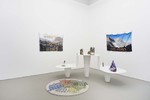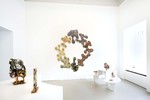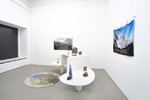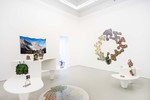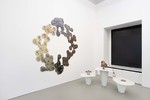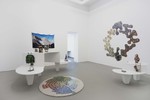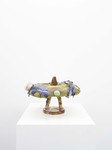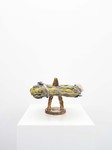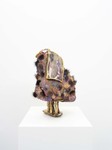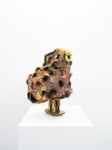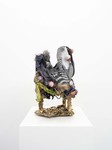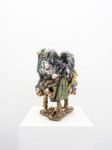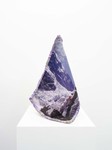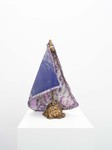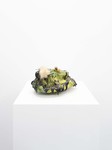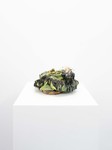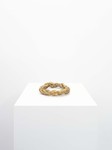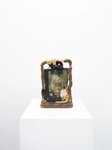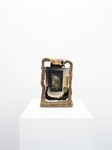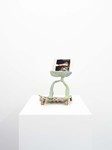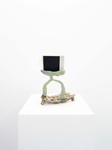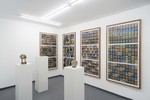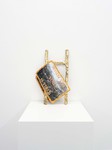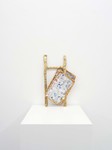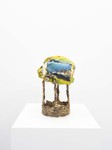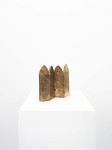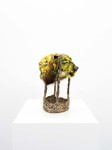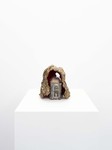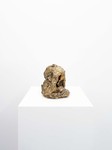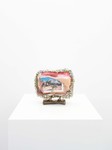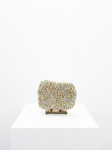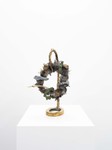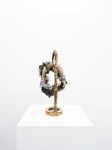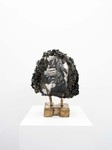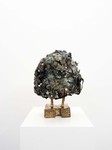We do not make ourselves. We cannot remake
ourselves through memory. Such was the
fallacy driving my memory theater. We are not
self-constituting beings. We are constituted
through the vast movement of history, of
which we are the largely quiescent effects.
Sundry epiphenomena. Symptoms of a
millennia-long malaise whose cause escapes
us. Memory theater cannot be reduced to my
memory, but has to reach down into the deep
immemorial strata that contain the latent
collective energy of the past. The dead who
still fill the air with their cries. The memory
theater would have to immerse itself in the
monumentally forgotten. Like a dredging
machine descending down through the lethic
waters of the contemporary world into the
sand, silt, and sludge of the sedimented past.
- Simon Critchley, Memory Theater
An Unkindness of Ravens
Wesley Simon
A cluster of symbols, feelings and experiences, Any Kind of Raven acts as
both a mnemonic repository and a living grimoire: invocations of memories and
moments of pastness, as well as world-building concepts that shape our
perceptions of reality, all appearing as so many deities and demigods of malleable
affect and temperament. It is an archive of spells, relics and icons that have deeply
mattered to each of the artists. Things that matter, have mattered, will matter,
coalescing in the alchemy of personal and collective memory and their
sublimation into both material and symbolic forms. It scrapes the edges of
nothingness to mine personal and collective significance, bringing together a
cascading array of matrices and tangled webs of the spectres of signification.
From the dialectical absurdity of unplayable “playing” cards that signify the
distillation of richly conceptual spheres into the precision of pithy incantations, to
the tangled nests of personal and social histories, sedimented and fused like
petrified mutations, the works in Any Kind of Raven map, codify, and amalgamate
the artists’ relations to place, world, and cosmos, to past, present, and future.
Through merging synthetic and organic forms, lexical and photographic
apparitions, and numerous points of reference and scale, these works remind us
that we are always thrown amidst a cluster of relations, like a chaotic flock, or as
the English expression goes, an unkindness of ravens, and that orienting ourselves
is always a form of aesthetic sorcery.
In his 1582 treatise on the relation between, and practical use of, signs,
images and ideas, De imaginum, signorum et idearum compositione, the
Renaissance philosopher and Dominican friar, Giordano Bruno, writes that all
beings fall into two distinct categories: things and their signifiers. The primary
concern of Bruno’s method of memory hinges upon this relation, or what he calls
the significance of things. While memory, both personal and collective, is the
ossuary of signification, memories are the signs and indications of things past,
stratified in the folds of temporality. It is precisely the invocation of such signs
that brings forth, like risen apostles in the catacombs of Rome, a world that is
constituted by the “collective energy of the past.” Being in the world is always a
mode of being-through-memory, the individual and collective past made present
from which the future is constantly emerging. The act of confronting this and
constructing a present space from which to ponder and navigate a world that is
always personal and social, terrestrial and cosmic, is a kind of ritual magic.
Art, as both reflection and investigation of the world, through unlimited
media, expression, and sensation, unveils the nuances of our myriad realities,
seemingly with no limitation that might lead to exhaustion. Of course, this very
word, “art,” is so convoluted and contested, and constantly contestable, that it is
essentially an empty signifier. Like the word “nothing,” it appears to signify some
thing, yet there is no stable referent to adhere to it. If nothingness is the vacuum
that somehow allows something to emerge, the space of poiesis, then perhaps art
is the aether that fills this emptiness with potential significance. More than mere
representation, it is a ritual for transformation and divination, between creator,
object and viewer.
Overfowing Condensations
In "Any Kind of Raven", the works of Nick Koppenhagen (1987, lives in Berlin) and Audrey Hope (1986, lives in Orlando, U.S.A.) bring together two complex personal systems and reveal commonalities in their respective artistic practices. The interweaving of different paths creates a concentration characterized by the simultaneity of associations, including contradictions. For example, in Koppenhagen's “Horizontal Twilight Spells” a permanent fickering between the real and its interpretation occurs when connections between places are drawn, and a superordinate system is imposed upon them. In the sculpture series “Disappointed Tourist”, Audrey Hope combines heterogeneous materials that would not
normally be associated with each other (bronze forms the foundation and is supplemented by various items, photos, and references). Both the multiple chains of association in Hope's objects and Koppenhagen's endlessly rearranging card layouts offer multiple readings of the same work, evoking an incessant oscillation between art, kitsch, and relic—to name just a few key terms. Considering the richness of allusions an overload is accepted, as is the contradiction that although these are playing cards, they are not meant to be played with (at least not in the conventional sense).
To avoid giving up in despair, a pair of “dream glasses” or a navigator of the subconscious could be helpful to spot biographical things that often serve as points of reference (is that Hope's brother in the photo?), or to fundamentally trace the intrinsic intensity of things, as both artists are concerned with objects as stores of memory and carriers of narratives (what do the medieval motifs on the cards tell us?).
Another commonality is walking—a rhythmic activity that has something ritualistic about it, and which in the form of memory walks represents the embodiment of remembrance.
It is also striking that the manner of presentation in the exhibition is a primary component of the works. Both artists have developed new displays for “Any Kind of Raven” that emphasize the dialogue between the two and in which elements of the artworks are continued. Thus the impressions repeat themselves and assemble, piece by piece, into a condensed cosmos.
Anna-Lena Wenzel
Translation: Sarah Dudley

